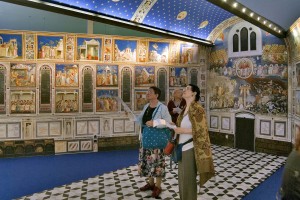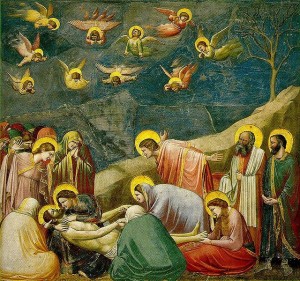Arena Chapel, Padua, view of the west wall and fresco painting of the Last Judgment, 1303-06
By Angela Levine
The story of this journey, the transference of a model of one of the principal fresco series in the world to the Holy Land, began a year ago when Flavio Zanonato, Mayor of Padua, made a private visit to St Saviour’s Monastery, Jerusalem, home to 200 Franciscan monks. According to Ettore Soranzo, their spokesman, Zanonato wished to express his appreciation for the work that the Franciscans are doing, particularly as regards assisting pilgrims. As a result, the city of Padua sent them a model of its most valuable possession – the Arena Chapel, with its interior decoration by the 14th century Florentine painter Giotto.
This gift to the Jerusalem Order was deemed especially appropriate since Giotto completed important commissions for the Franciscan church. Relevant also was the fact that the background to this cycle of paintings, depicting events in the Life of Christ and the Life of the Virgin, is the Holy Land, landscapes and places that Giotto depicted from his imagination.
Models of the Arena chapel have already been displayed in museum locations in South America and Europe, but the city of Padua raised money in order to send a beautiful new model to Jerusalem. On arrival it was housed in the lobby of the monastery where it was seen by Nirit Shalev-Khalifa, a Ph.D student in the art history department of Tel Aviv University. It was she who first put forward the idea of approaching the Franciscans as regards exhibiting this model outside the monastery. Consultations between representatives of the Order and officials from the Eretz Israel Museum followed; final permission being given by Father Pierbattista Pizzaballa whose official title is Custodian of the Holy Land.
Because of its remarkable beauty, its historical and artistic importance, the display of this model has brought a large number of visitors to the Museum, and the closing date of the exhibit has been extended. According to Soranzo, plans are underway to exhibit the model in other Israeli cities, among them Haifa and Nazareth.
The origin of the Arena chapel, also known as the Cappella Scrovegni, is another fascinating story. It was built at the start of the 14th century by Enrico Scrovegni, a wealthy Paduan merchant, on a plot of land in the area near a Roman amphitheater – known as the Arena. The family’s wealth had been amassed by his father, Reginaldo, a money-lender. Since usury was considered a sin in the Middle Ages, the dedication of this chapel in March 1305 to the Virgin of Charity is thought to have been the means by which Enrico Scrovegni hoped to redeem his father’s sins as well as save his own soul.

Most historians believe that Giotto’s frescoes were largely completed by the dedication date. Executed al fresco (painting on freshly spread plaster before it dries,) it is presumed that the less important details were painted by his assistants; otherwise the work would have taken far longer than the estimated three to five years.
On the chapel’s western wall (seen straight ahead when entering the model), is a large painting of the Last Judgment; the Blessed in Heaven on one side, the Damned in Hell on the other. Giotto has immortalized the likeness of Enrico Scrovegni in this scene, including him in the company of the Blessed where, on bended knee, he presents the Virgin Mary with a model of the Arena chapel.
Depicted on the side walls of the chapel, in the upper of three horizontal registers, are episodes in the lives of Mary’s parents, Anne and Joachim; while scenes of Christ as a young man and the stages of his Passion are located on the two lower registers.
At floor level is a faux architectural scheme of painted marble slabs and niches containing personifications of the seven virtues and seven vices. Among them is Wrath, a woman tearing the bodice of her dress; and Envy, whose poisonous tongue is symbolized by a serpent coming out her mouth. These niches and figures give the impression of having been carved from stone, but this is not so. Employing tone-on-tone (grisaille) painting, Giotto created an illusion of depth on a flat surface, reviving a technique that painters had not used for a thousand years.
Why are the Arena Chapel frescoes considered so important? Giotto was living in an era of great change. Universities were replacing monasteries as centers of learning and culture and many new ideas were afoot. Prominent was the conviction that life on this earth was truly significant. It was not, as previously believed, just a preparation for the world to come. In tune with the times, Giotto discarded a medieval style of painting in which stiff, unreal imagery suited this outdated belief. Instead, he brought humanity, realism and emotion to his subject matter, and, as one sees in these paintings, positioned his figures in illuminated, three-dimensional space rather than against a flat and neutral background as earlier generations of artists had done.
New too, was Giotto’s decision, in this his first masterpiece, to make each painting an independent unit, having its own structure, color-scheme and narrative. This innovation was in contrast to religious paintings of the past, where two or even three episodes taking place at different times and in different places were brought together in one picture.

Giotto is also considered to be the first painter to portray Nature realistically. This is illustrated, for example in the painting The Flight of the Holy Family into Egypt (which took place after Joseph, Jesus’ father, was warned in a dream that Herod was searching for the infant to kill him). In this work, where modeling with light and shade suggests the physical characteristics of each dignified figure (even the donkey steps out with grace,) the barren and lonely character of the landscape is effectively depicted.

Giotto’s ability to express emotion is especially evident in The Lamentation over the Body of Jesus, one of the most captivating paintings in the Arena cycle. Here, by gestures and by the expressions on the faces of the mourners, he paints an unforgettable picture of human sorrow. Among the group centered around Jesus is John, his disciple, who flings back his arms in grief, while Mary is shown supporting the upper part of her son’s body. A veiled woman takes his head in her hands. In the sky, angels descending from heaven take up the theme of mourning.
Prof. Nurith Kenaan-Kedar, who heads the scientific committee of the Eretz Israel Museum, was asked if she approved of a model of this great work being put on display. Her response was very positive: “For educational purposes, this substitute is invaluable. At one time, visitors to the Arena Chapel in Padua were allowed in without booking and permitted to study the paintings for as long as they liked. Since 2001, entrance is restricted and visitors are only allowed 15 minutes inside the chapel, giving them almost no time to study the works.” Of course,” she said, “from a model one can’t experience the same emotions that just being inside the Chapel evoke. Nevertheless, this beautiful reproduction is an excellent way to gain detailed knowledge of the frescoes and prepare people, if the opportunity arises, for viewing the originals.” A scholarly text on the Arena Chapel frescoes written by Kenaan- Kedar is available at the entrance to the exhibit.
For people who don’t read Hebrew and want to get the most from viewing this model, descriptive material is available at: http://www.wga.hu/frames-e.html?/html/g/giotto/padova/ and http://www.wga.hu/tours/giotto/padova/index25.html The Giotto exhibit is sited inside the Glass Pavilion at Eretz Israel Museum, Ramat Aviv and is open until January 30th 2010.





